It was a bright and sunny day for my visit to old friends Wolf and Luci. Jackie, as usual 
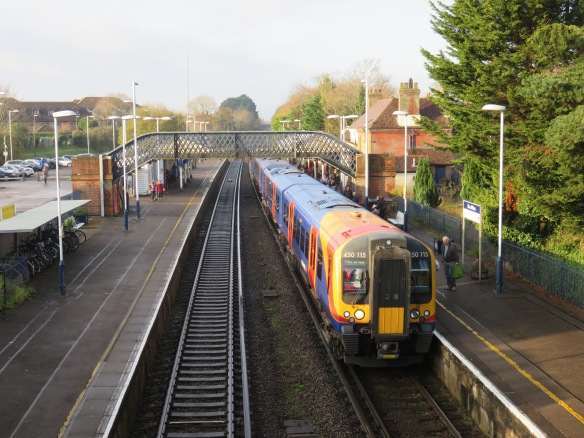 drove me to and from New Milton Station for the train to Waterloo. From the terminal, I took the Northern Line to Clapham Common, along the South Side of which I walked,
drove me to and from New Milton Station for the train to Waterloo. From the terminal, I took the Northern Line to Clapham Common, along the South Side of which I walked,  crossing over to Elms Road, right into Abbeville Road, and left into Hambalt Road to their home. I returned home by the same methods.
crossing over to Elms Road, right into Abbeville Road, and left into Hambalt Road to their home. I returned home by the same methods.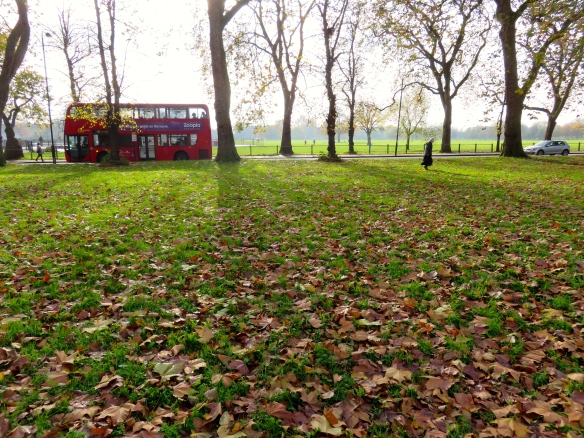
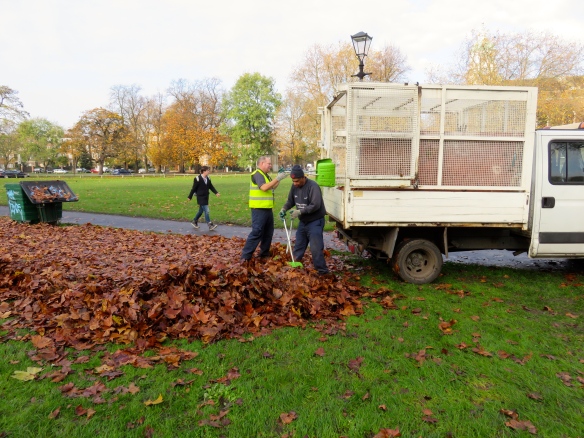
Maple leaves were falling on the common where work forces were engaged in clearing them up, mostly with extended ‘big hands’ to aid the process. 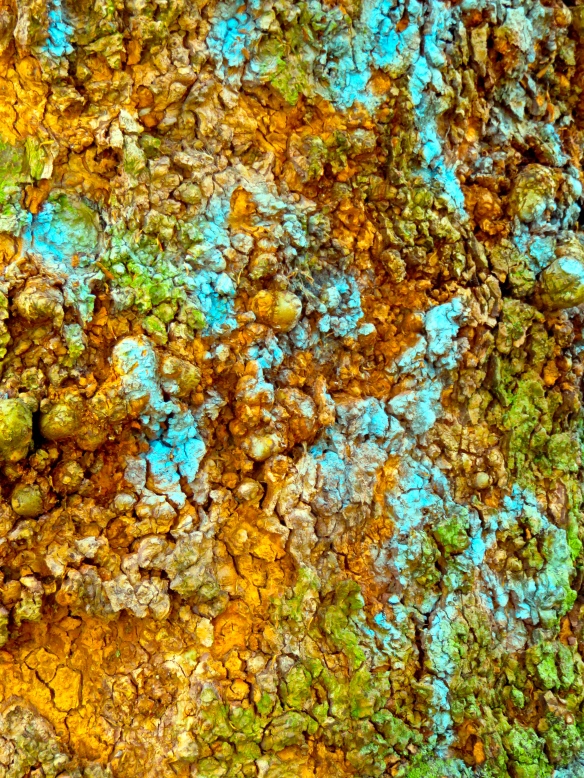 Blue pigment on a particularly gnarled trunk produced an interesting abstract painting.
Blue pigment on a particularly gnarled trunk produced an interesting abstract painting.


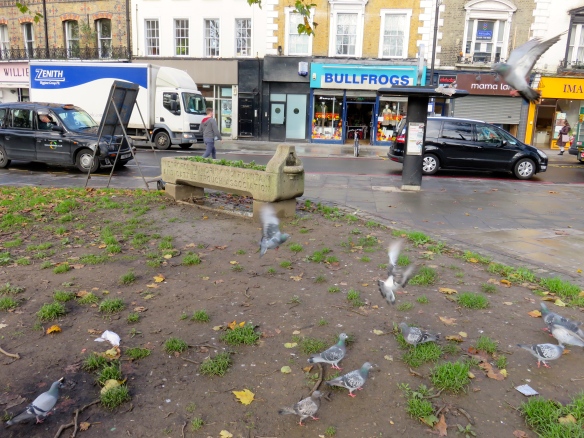 Pigeons, rooks, and Canada geese scratched about in well clawed soil, and Bullfrogs overlooked the redundant cattle trough, now planted with flowers.
Pigeons, rooks, and Canada geese scratched about in well clawed soil, and Bullfrogs overlooked the redundant cattle trough, now planted with flowers.
 Also apparently redundant, certainly unusable, is the drinking fountain provided by The United Kingdom Temperance and General Provident Association. This grand sculptured structure, even if it were functioning as it did in Victorian times, would probably be eschewed by the various gentlemen occupying the benches as they glugged alcoholic beverages straight from their cans.
Also apparently redundant, certainly unusable, is the drinking fountain provided by The United Kingdom Temperance and General Provident Association. This grand sculptured structure, even if it were functioning as it did in Victorian times, would probably be eschewed by the various gentlemen occupying the benches as they glugged alcoholic beverages straight from their cans. 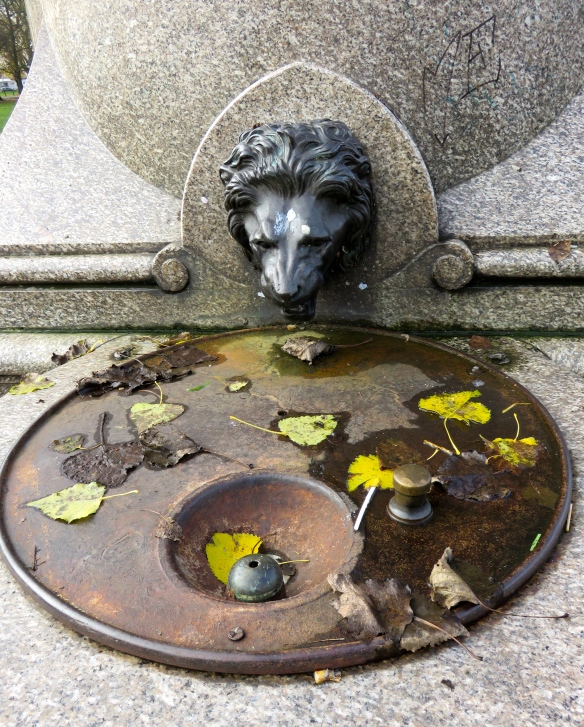 The lions embellishing each side would probably never again have their thirsts slaked by the blocked and rusting fountain.
The lions embellishing each side would probably never again have their thirsts slaked by the blocked and rusting fountain.
When I lived or worked in London I had enjoyed a monthly lunch with my friends. Unfortunately this frequency is no longer possible but whenever Jackie and I see them it is equally pleasurable, as it was today. Today Luci produced a tender lamb casserole, wild rice, parsnips, and brussels sprouts, followed by her trademark flavoursome crustless pumpkin pie. She and I both drank Wolf Blass red wine, while Wolf drank his customary apple juice.
Luci wrapped up a helping of the dessert for Jackie, who enjoyed it as much as I did. After that superb lunch, I didn’t join my lady for dinner.
 On my return home I was greeted by an e-mail from Luci containing very good photographs of Wolf and me taken with her Samsung mobile phone.
On my return home I was greeted by an e-mail from Luci containing very good photographs of Wolf and me taken with her Samsung mobile phone.
Tag: Canada Geese
Invasive Species
The strong winds are back. Although the skies are a fairly uniform dull grey, where there are differences in nuances, wispy streaks rush over their lighter neighbours like smoke from a bonfire, or what was soon to emanate from the car bonnet. The rain was not heavy, but the gusts blew Jackie and me up and down the gravel slopes crossing the heath on which we walked at Frogham where she had driven us this morning.
On Roger Penny Way there were two sets of temporary traffic lights marking spots where trees had presumably fallen across the road. One root mass circumference was quite the largest either of us has seen. For a short stretch around Godshill, vehicles, and the inevitable Sunday cyclists, had to share the road with runners as they strung out along the tarmac before disappearing through the car park into Ashley Walk which winds across the heath.
For a short stretch around Godshill, vehicles, and the inevitable Sunday cyclists, had to share the road with runners as they strung out along the tarmac before disappearing through the car park into Ashley Walk which winds across the heath.
That resting place for cars was bone dry compared with the one at Abbot’s Well where Jackie normally parks when we go to that part of the forest. The road up to the second car park is normally pitted and can be muddy. 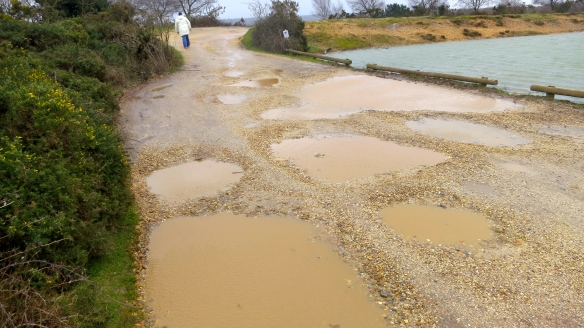 Today the pock marks had widened and deepened and were filled with ochre liquid, some of which may have come from the glaucous lake which was even now lapping at the fenders alongside it. Fortunately we managed to leave the car in the lower section.
Today the pock marks had widened and deepened and were filled with ochre liquid, some of which may have come from the glaucous lake which was even now lapping at the fenders alongside it. Fortunately we managed to leave the car in the lower section.
 The poster visible by the lake in the picture above explains that work is under way to control New Zealand pygmyweed which is threatening native New Forest plants. This perennial species of succulent, the Crassula helmsii, otherwise known as the swamp stonecrop, that has been introduced from the Antipodes, likes aquatic or semiterrestrial conditions.
The poster visible by the lake in the picture above explains that work is under way to control New Zealand pygmyweed which is threatening native New Forest plants. This perennial species of succulent, the Crassula helmsii, otherwise known as the swamp stonecrop, that has been introduced from the Antipodes, likes aquatic or semiterrestrial conditions.  Given the amount of water that has lain on the forest terrain for the last two years it is hardly surprising that this invader is enjoying itself.
Given the amount of water that has lain on the forest terrain for the last two years it is hardly surprising that this invader is enjoying itself.
The John Tradescants, father and son, were seventeenth century travellers and gardeners who imported many new species of plant, some of which, named after them, are welcome additions to our flora. Others have, for various reasons, introduced both flora and fauna, some of which have come to be less than welcome.
 A warning about Himalayan balsam is posted on the Castleman Trailway near Ringwood. ‘Himalayan balsam (Impatiens glandulifera) is a relative of the busy Lizzie, but reaches well over head height, and is a major weed problem, especially on riverbanks and waste land, but can also invade gardens. It grows rapidly and spreads quickly, smothering other vegetation as it goes’ (RHS). I’m sure I’ve seen and, unknowingly admired it.
A warning about Himalayan balsam is posted on the Castleman Trailway near Ringwood. ‘Himalayan balsam (Impatiens glandulifera) is a relative of the busy Lizzie, but reaches well over head height, and is a major weed problem, especially on riverbanks and waste land, but can also invade gardens. It grows rapidly and spreads quickly, smothering other vegetation as it goes’ (RHS). I’m sure I’ve seen and, unknowingly admired it.
There are more than 1,000 species of rhododendron, many of which were introduced to England, I believe from China, in the 18th Century. Their splendour is evident in Furzey Gardens and in ours. 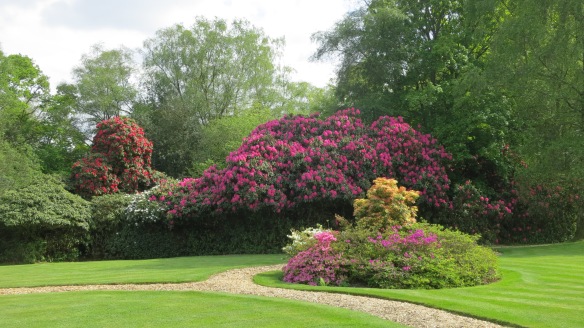 Unfortunately ‘some types are now a pest in Britain, because they out-compete many native plants and, because their leaves contain toxins that some animals find inedible’.
Unfortunately ‘some types are now a pest in Britain, because they out-compete many native plants and, because their leaves contain toxins that some animals find inedible’.
In 17th Century, Canada Geese were introduced to supplement King James II’s waterfowl collection in St James’s Park. 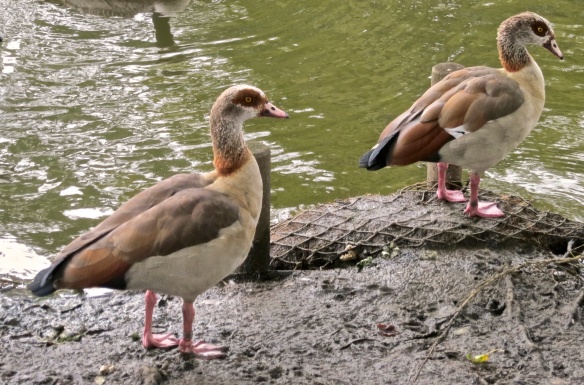 Just like any other living creature, the young of these large birds, as I found in Cannon Hill Common on 28th September 2012, are intriguing and attractive. They do, however grow up, and are now a menace on our lakes and rivers. Their excreta is rather copious and can clog up the land around the waterways preventing grass from growing.
Just like any other living creature, the young of these large birds, as I found in Cannon Hill Common on 28th September 2012, are intriguing and attractive. They do, however grow up, and are now a menace on our lakes and rivers. Their excreta is rather copious and can clog up the land around the waterways preventing grass from growing.
 Another menace, thought to have been eradicated by 1989, is the coypu, introduced from South America in 1929. This was kept in East Anglia for its fur. Some escaped, went forth, and multiplied. These creatures are extremely destructive. Was the ‘giant rat’ killed in County Durham in 2012, a survivor of the slaughter? If so, how many more are there?
Another menace, thought to have been eradicated by 1989, is the coypu, introduced from South America in 1929. This was kept in East Anglia for its fur. Some escaped, went forth, and multiplied. These creatures are extremely destructive. Was the ‘giant rat’ killed in County Durham in 2012, a survivor of the slaughter? If so, how many more are there?
When we came back to the car at Abbot’s Well today, it would not start. The water with which we had filled the tank yesterday was all gone. We had just enough left in a bottle to enable us to limp home, but we have a problem. The car didn’t smell too good and steam clouds rose from outside the front.
We had thought the lack of transport would mean that we would be unable to attend Helen’s birthday party this afternoon, but Ron collected us and took us to Poulner, and Shelly drove us home afterwards. Stretching into the evening we had an enjoyable time with friends and family involving much reminiscing and a certain amount of alcohol. My choice was red wine. There were plenty of well-filled and inventive canapés, and Helen kept warm snacks such as sausage rolls, and pastry filled with pork and apricots, flowing from the kitchen.
Cyclists, Geese, Ducks, And Tourists
This morning I walked to Becky’s home, meeting Jackie who had driven there. The route took me via the Mitcham cricket green and across the common. Walking along Cricket Green on one side of the eponymous conservation area, with the flamboyant clubhouse alongside Mary Tate’s almshouses across the road, one is reminded of how beautiful Mitcham was in days gone by.
Along one stretch of Morden Hall Road half the pavement has been designated for cyclists. I have never seen a cyclist using it. London has many such stretches of pavement reducing the width of pedestrian footpaths. The only one I have ever seen used is actually the first one I experienced. That is on a stretch of road between Balderton and Newark in Nottinghamshire. Cyclists may have availed themselves of this, but the ratepayers were less than happy about the expense. Bicycles ridden on the undesignated pavement can, however, be a menace on the busier inner London roads. They often speed along, weaving in and out among pedestrians, and steaming around corners with frightening disregard for their or other people’s safety. I was once clipped on the arm by one on the pavement in The Strand. As this was in my running days I set off after him and caught him up at traffic lights. He was rather surprised. Perhaps not only because I didn’t hit him. I just had a quiet word.
The roads, of course are unsafe for cyclists, choked as they are with drivers of varying ability. I don’t really know what the answer is, but surely it can’t be Boris’s Bikes which add more riders to already densely occupied streets. Interestingly, the only pavement- encroaching cyclist I’ve ever seen challenged by a policeman was a man mounting the kerb to replace a Boris Bike in a rack alongside Westminster Cathedral.
Having rounded the cricket green and on approaching the A236 roundabout on the wide pavement I was overtaken by a cyclist who wobbled past me on the inside and teetered across my path into and across this major road weaving his way through the cars approaching the junction before continuing his journey along the opposite footpath. I swear I had my earlier thoughts before this happened.
Much of my continuing journey involved crossing Mitcham Common. Only ever having driven and, I admit it, albeit 45 years ago, cycled along the major roads through the common, I had not realised what a pleasant amenity this is. The path I took between Commonside West and Windmill Road has at some time in the not too distant past been planted with an avenue of oaks. A lake in the middle of the common was home to large number of Canada Geese including a mother shepherding her troop of goslings and hissing at me. These large birds which are now rife in our public parks and canalsides were introduced into this country as long ago as the end of the 17th. century. It was about the middle of the 19th. century that fortunes were made in Peruvian guano, that is sea-bird droppings, which was highly valued as a fertiliser. Maybe there is an opportunity for an entrepeneurial individual prepared to collect the masses of Canada Geese excretia, just as Mr. Figg, one of my childhood neighbours, collected horse droppings left by the rag-and-bone man’s steed to spread on his garden.
My path across the common was twice crossed by a skein of what I took to be tourists under the direction of a guide. They would occasionally stop for a lecture or explanation. As I watched them file after their leader I was reminded of the duck that had once taken over the pond in our garden at Lindum House. She came in off the road and trotted down the drive followed by a string of her babies; inspected all the walls and fences bordering the garden, the ducklings following in single file; and when satisfied finally settled her family on the small pond which I had dug myself. Perhaps the goslings also influenced this memory.
I met a postman when nearing Becky’s flat, and we had a laugh about the chaotic street layout and house numbering in the area, Westmorland Way being the most confusing.
After a day with Becky Jackie fed us all on an excellent chicken casserole after which she and I returned to Morden, both by car.